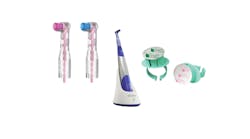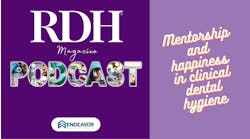Becoming a dental hygienist is an exceptional accomplishment. Once we graduate from hygiene school and pass national boards, we’re eager to hit the ground running and jump start our career. Little do we realize that pain may be lurking around the next corner. Studies show that up to 92% of dental hygienists suffer from musculoskeletal disorders (MSDs).1 These can sneak up on us before we know it. Take it from my experience.
About four months into my career, I noticed some periodic pain while working on patients. At first, I didn’t pay much attention to it and thought it would pass. But as the time went by, the pain cycle just got worse. After much research, I learned about the importance of proper ergonomics and mobility exercises. At that moment, I knew that to have a long-lasting career, I would need to implement ergonomics into my daily routine.
There are some signs and symptoms that hygienists should be aware of and not ignore. The first thing I felt was “burning” between my shoulder blades. This happened while I was scaling patients. By the end of the day, I was almost in tears. My body was not used to this type of work. Back pain has been found to be a major health problem for dental professionals.2 Inexperienced dental hygienists introduce their bodies to new positions and make their muscles work in ways they’ve never worked before. These muscles tense up and cause painful trigger points and muscle knots.
Related reading
Pain on the job: How bad is it?
Chronic pain from muscular imbalances: How to exercise correctly to avoid pain
Besides my back, my left shoulder developed twinges of discomfort. I noticed this symptom while I was retracting the cheek with my mirror, when I often have my left arm held out. I was also super tight and tense in my upper trapezoids. I later realized how incorrect my working posture was. It’s hard for new grads to be familiar with proper patient chair adjustment. Ideally, we want a patient to be low enough that their mouth is at or slightly lower than the elbows, with our forearms parallel to the floor3 and close to our sides to avoid “chicken winging.”
A few months later I came home every day with a stiff and aching neck. This led to daily headaches that lasted all night. Neck pain is the most common complaint among dental hygienists.2 I did not realize how much damage and strain I was placing on my neck just by flexing it forward to see into patients’ mouths.
Unfortunately, with all the twisting, reaching, and awkward positions we repetitively place our bodies in, we can cause severe physical and mental distress.3 This may sound discouraging, but there is hope!
What helped me
Since poor and static posture is one of the main culprits of work-related pain,3 proper equipment in the operatory should be addressed first. Ergonomic loupes are a game-changer; they prevent you from having to bend your neck too much, which means less strain on the cervical spine. Saddle chairs are becoming more popular because they place the body in a neutral position and thus minimize neck and back pain.3 A saddle chair allows you to be in closer proximity to the patient so there is less reaching your arms forward and hunching your back to see into the oral cavity.
I’ve found that certain dental pillows work great to support a patient’s neck. A neck pillow enables you to recline the patient further back more comfortably, which allows better access to the mouth. You can place a pillow under their neck, then drop the headrest to get closer to the patient if necessary.
Stretches are easily done in the operatory between patients. These should be done on the muscles that have become contracted and overactive due to static postures.3 Hold each stretch for 10 to 20 seconds. Another technique that helps relieve tightness is trigger point therapy. Find a tender area in your muscle and hold it with pressure for 20 to 30 seconds.3 You can achieve this through foam rolling or with a tennis ball in the operatory, and you can do this between patients. Specific mobility exercises should be done to help with flexibility and strengthen weakened muscles to promote better posture.
Being a dental hygienist is rewarding and fulfilling. Being aware of proper ergonomics and body mechanics is key to better serve your patients and have a long-lasting career.






